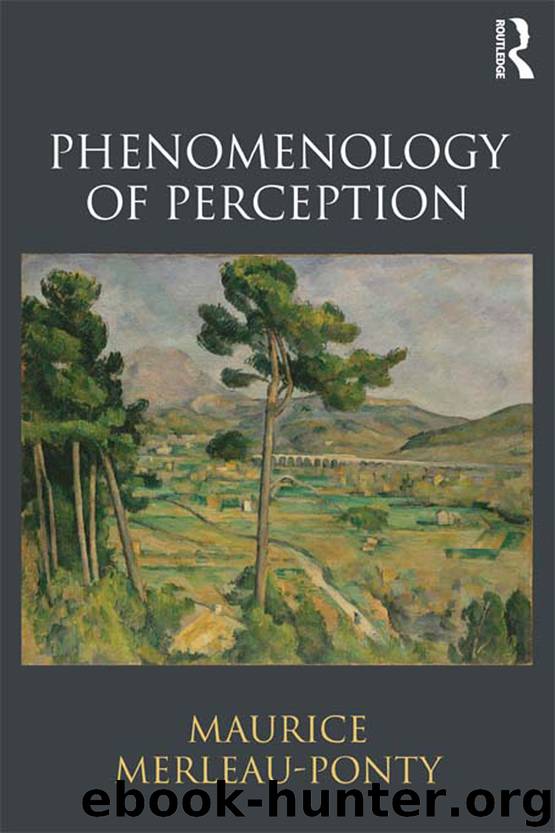Phenomenology of Perception by Merleau-Ponty Maurice;

Author:Merleau-Ponty, Maurice;
Language: eng
Format: epub
Publisher: Routledge
[C. Movement.]
[i. Thinking about movement destroys movement.]
Even if it cannot be defined in this way, movement is a displacement or a change of position. Just as we initially encountered a conception of position that defined it through relations in objective space, so too is there an objective conception of movement that defines it through intra-worldly relations by taking the experience of the world as acquired. And just as we had to uncover the origin of spatial position in the pre-objective situation or locality of the subject who focuses upon his milieu, so too will we have to rediscover beneath the objective thought of movement a pre-objective experience from which it borrows its sense and where movement, still tied to the person who perceives, is a variation of the subject’s hold upon his world. When we attempt to think movement or to undertake the philosophy of movement, we immediately place ourselves in the critical attitude or the attitude of verification: we ask ourselves what is actually given to us in movement, we prepare ourselves for rejecting appearances in order to attain the truth of movement, and we fail to notice that it is precisely this attitude that reduces the phenomenon and that will block us from attaining it itself, because this attitude introduces – along with the notion of truth in itself – presuppositions capable of concealing from me the birth of movement.
I throw a stone. It crosses my garden. For a moment, it becomes a blurry meteorite and then, falling to the ground in the distance, it again becomes a stone. If I want to think the phenomenon “clearly,” I must decompose it. The stone itself, I will say, is not in fact modified by the movement. I find again on the ground at the end of its trajectory the very same stone I held in my hand, and thus it is the same stone that moved through the air. Movement is but an accidental attribute of the moving object [le mobile], and it cannot somehow be seen in the stone. It can be nothing but a change in the relations between the stone and the surroundings. We can only speak of a change if the same rock persists beneath the different relations to the surroundings. On the contrary, if I assume that the stone is annihilated upon arriving at point P, and that another identical stone springs forth at point P′, as adjacent to the first as one would like, then we no longer have a unique movement, but rather two movements. There is, then, no movement without a moving object that bears it uninterruptedly from the starting point right through to the end point. Since it is in no way inherent to the moving object and consists entirely in its relations to the surroundings, movement does not work without an external reference point, and, in short, there is no means of attributing movement exclusively to the “moving object” rather than to the reference point.
Once the distinction between the
Download
This site does not store any files on its server. We only index and link to content provided by other sites. Please contact the content providers to delete copyright contents if any and email us, we'll remove relevant links or contents immediately.
The remains of the day by Kazuo Ishiguro(7550)
Tools of Titans by Timothy Ferriss(6945)
The Black Swan by Nassim Nicholas Taleb(6190)
Inner Engineering: A Yogi's Guide to Joy by Sadhguru(5894)
Giovanni's Room by James Baldwin(5877)
The Way of Zen by Alan W. Watts(5798)
The Six Wives Of Henry VIII (WOMEN IN HISTORY) by Fraser Antonia(4789)
The Power of Now: A Guide to Spiritual Enlightenment by Eckhart Tolle(4753)
Astrophysics for People in a Hurry by Neil DeGrasse Tyson(4619)
Asking the Right Questions: A Guide to Critical Thinking by M. Neil Browne & Stuart M. Keeley(4574)
12 Rules for Life by Jordan B. Peterson(3733)
The Ethical Slut by Janet W. Hardy(3502)
Skin in the Game by Nassim Nicholas Taleb(3459)
Housekeeping by Marilynne Robinson(3401)
The Art of Happiness by The Dalai Lama(3382)
Double Down (Diary of a Wimpy Kid Book 11) by Jeff Kinney(3272)
Skin in the Game: Hidden Asymmetries in Daily Life by Nassim Nicholas Taleb(3264)
Walking by Henry David Thoreau(3234)
12 Rules for Life: An Antidote to Chaos by Jordan B. Peterson(3200)
